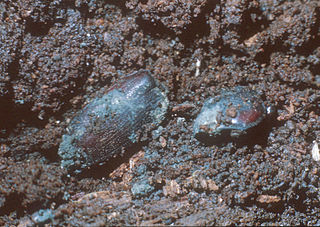
Locusts are various species of short-horned grasshoppers in the family Acrididae that have a swarming phase. These insects are usually solitary, but under certain circumstances they become more abundant and change their behaviour and habits, becoming gregarious. No taxonomic distinction is made between locust and grasshopper species; the basis for the definition is whether a species forms swarms under intermittently suitable conditions; this has evolved independently in multiple lineages, comprising at least 18 genera in 5 different subfamilies.

Grasshoppers are a group of insects belonging to the suborder Caelifera. They are amongst what are possibly the most ancient living groups of chewing herbivorous insects, dating back to the early Triassic around 250 million years ago.

The desert locust is a species of locust, a periodically swarming, short-horned grasshopper in the family Acrididae. They are found primarily in the deserts and dry areas of northern and eastern Africa, Arabia, and southwest Asia. During population surge years, they may extend north into parts of Southern Europe, south into Eastern Africa, and east in northern India. The desert locust shows periodic changes in its body form and can change in response to environmental conditions, over several generations, from a solitary, shorter-winged, highly fecund, non-migratory form to a gregarious, long-winged, and migratory phase in which they may travel long distances into new areas. In some years, they may thus form locust plagues, invading new areas, where they may consume all vegetation including crops, and at other times, they may live unnoticed in small numbers.

Beauveria bassiana is a fungus that grows naturally in soils throughout the world and acts as a parasite on various arthropod species, causing white muscardine disease; it thus belongs to the group of entomopathogenic fungi. It is used as a biological insecticide to control a number of pests, including termites, thrips, whiteflies, aphids and various beetles. Its use in the control of bed bugs and malaria-transmitting mosquitos is under investigation.

The red locust is a large grasshopper species found in sub-Saharan Africa. Its name refers to the colour of its hind wings. It is sometimes called the criquet nomade in French, due to its nomadic movements in the dry season. When it forms swarms, it is described as a locust.
Entomopathogenic fungi are parasitic unicellular or multicellular microorganisms belonging to the kingdom of Fungi, that can infect and seriously disable or kill insects.
Metarhizium robertsii is a fungus that grows naturally in soils throughout the world and causes disease in various insects by acting as a parasitoid. It is a mitosporic fungus with asexual reproduction, which was formerly classified in the form class Hyphomycetes of the phylum Deuteromycota.

Metarhizium is a genus of entomopathogenic fungi in the family Clavicipitaceae. With the advent of genetic profiling, placing these fungi in proper taxa has now become possible. Most turn out to be the asexual forms (anamorphs) of fungi in the phylum Ascomycota, including Metacordyceps spp.

The Australian plague locust is a species of locust in the family Acrididae native to Australia, where it is a significant agricultural pest.

The Senegalese grasshopper is a medium-sized grasshopper species found in the Sahel region of Africa, the Canary Islands, Cape Verde Islands, and West Asia. Although not called a locust in English, this species shows gregarious behaviour and some morphological change on crowding. In many parts of the Sahel, this species may cause greater year-on-year crop damage than better-known locusts, attacking crops such as the pearl millet.

The brown locust is a medium-sized small locust species in the monotypic genus Locustana. It is found in Southern Africa and shows classic gregarious behaviour with phase polymorphism on crowding.

The African rice grasshopper, Hieroglyphus daganensis is a medium-sized grasshopper species found in the Sahel region. Although not called a locust in English, this species shows gregarious behaviour and some morphological change on crowding and may become a moderately important pest species for small-holder farmers in the region.

Metarhizium acridum is the new name given to a group of fungal isolates that are known to be virulent and specific to the Acrididea (grasshoppers). Previously, this species has had variety status in Metarhizium anisopliae ; before that, reference had been made to M. flavoviride or Metarhizium sp. describing an "apparently homologous and distinctive group" of isolates that were most virulent against Schistocerca gregaria in early screening bioassays.

Metarhizium majus is the name given to a group of fungal isolates that are known to be virulent against Scarabaeidae, a family of beetles. Previously, this species has had variety status in Metarhizium anisopliae and its name is derived from characteristically very large spores for the genus Metarhizium. There has been considerable interest in developing isolates of this species into mycoinsecticides: especially against the coconut and oil palm beetle pest Oryctes in SE Asia, the Pacific region and Africa.

Metarhizium flavoviride is a Sordariomycete in the order Hypocreales and family Clavicipitaceae. The genus Metarhizium currently consists of over 70 described species and are a group of fungal isolates that are known to be virulent against Hemiptera and some Coleoptera. M. flavoviride is described as its own species, but there also exists a variety of M. flavoviride, which is M. flavoviride var. flavoviride. Previously described varieties of M. flavoviride have been documented, however recent random amplified polymorphic DNA (RAPD) markers have assigned these varieties as new species. The reassigned species are as follows: M. flavoviride Type E is now M. brasiliense; M. flavoviride var. minus is now M. minus; M. flavoviride var. novozealandicum is now M. novozealandicum; and M. flavoviride var. pemphigi is now M. pemphigi.

Pandora is a genus of fungi within the order Entomophthorales. This has been supported by molecular phylogenetic analysis.
Metarhizium brunneum is the re-instated name of a group of reassigned Metarhizium isolates, previously grouped in the species "Metarhizium anisopliae var. anisopliae": based on a multigene phylogenetic approach using near-complete sequences from nuclear DNA. It is a mitosporic fungus with asexual reproduction, which was formerly classified in the form class Hyphomycetes of the form phylum Deuteromycota. M. brunneum has been isolated from Coleoptera, Lepidoptera, Diptera and soil samples, but a commercially developed isolate (below) has proved virulent against Hemiptera and Thysanoptera.
Entomophaga grylli is a fungal pathogen which infects and kills grasshoppers. It is the causal agent of one of the most widespread diseases affecting grasshoppers. This is sometimes known as summit disease because infected insects climb to the upper part of a plant and grip the tip of the stem as they die; this ensures widespread dispersal of the fungal spores. The fungus is a species complex with several different pathotypes, each one of which seems to be host-specific to different subfamilies of grasshoppers. The pathogen is being investigated for its possible use in biological pest control of grasshoppers.

Penicillium digitatum is a mesophilic fungus found in the soil of citrus-producing areas. It is a major source of post-harvest decay in fruits and is responsible for the widespread post-harvest disease in Citrus fruit known as green rot or green mould. In nature, this necrotrophic wound pathogen grows in filaments and reproduces asexually through the production of conidiophores and conidia. However, P. digitatum can also be cultivated in the laboratory setting. Alongside its pathogenic life cycle, P. digitatum is also involved in other human, animal and plant interactions and is currently being used in the production of immunologically based mycological detection assays for the food industry.

Metarhizium anisopliae is the type species in its genus of fungi, that grows naturally in soils throughout the world and causes disease in various insects by acting as a parasitoid. Ilya I. Mechnikov named it Entomophthora anisopliae (basionym) after the insect species from which it was originally isolated – the beetle Anisoplia austriaca and from these early days, fungi such as this have been seen as potentially important tools for pest management. It is a mitosporic fungus with asexual reproduction, which was formerly classified in the form class Hyphomycetes of the phylum Deuteromycota.
















